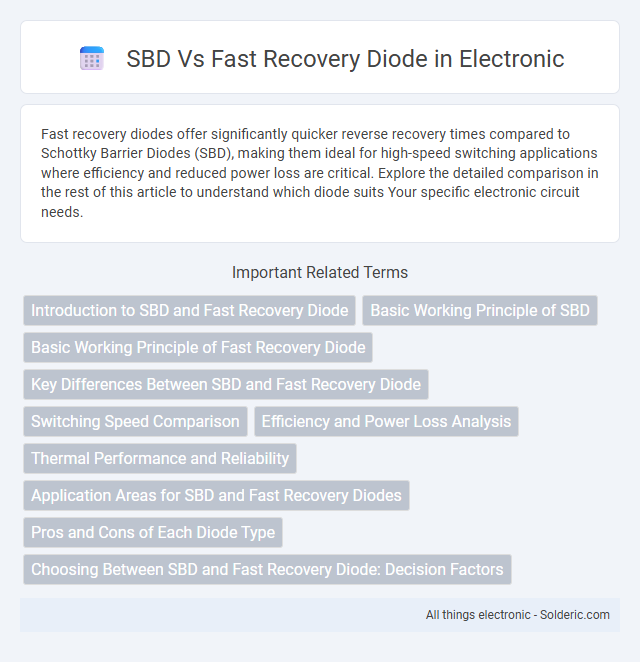Fast recovery diodes offer significantly quicker reverse recovery times compared to Schottky Barrier Diodes (SBD), making them ideal for high-speed switching applications where efficiency and reduced power loss are critical. Explore the detailed comparison in the rest of this article to understand which diode suits Your specific electronic circuit needs.
Comparison Table
| Feature | SBD (Schottky Barrier Diode) | Fast Recovery Diode |
|---|---|---|
| Forward Voltage Drop | Low (typically 0.2 - 0.4 V) | Higher (typically 0.7 - 1.1 V) |
| Recovery Time | Very fast (nanoseconds) | Fast but slower than SBD (microseconds) |
| Reverse Leakage Current | Higher leakage current | Lower leakage current |
| Reverse Voltage Rating | Lower (typically up to 100 V) | Higher (up to several hundred volts) |
| Switching Applications | High efficiency in high-frequency circuits | Suitable for medium-speed switching circuits |
| Typical Applications | Power supplies, RF circuits, rectifiers | Power rectifiers, inverters, motor drives |
| Cost | Generally higher | Generally lower |
Introduction to SBD and Fast Recovery Diode
Schottky Barrier Diodes (SBD) feature a low forward voltage drop and fast switching speed, ideal for high-frequency and low-voltage applications. Fast Recovery Diodes are designed to minimize reverse recovery time, making them suitable for power rectification and high-speed switching in circuits with rapid current changes. Understanding the differences helps you select the best diode type for efficiency and performance in your electronic designs.
Basic Working Principle of SBD
Schottky Barrier Diode (SBD) operates using a metal-semiconductor junction, where electron flow occurs with minimal energy barrier, resulting in low forward voltage drop and fast switching speed. This efficient conduction mechanism reduces power loss compared to fast recovery diodes, which rely on a p-n junction and involve charge storage during switching. Your choice of SBD can enhance performance in high-frequency and low-voltage applications due to its superior switching characteristics and lower forward voltage.
Basic Working Principle of Fast Recovery Diode
Fast recovery diodes operate by quickly switching from the conducting to the blocking state, minimizing reverse recovery time and reducing switching losses compared to standard diodes. Unlike Schottky Barrier Diodes (SBD), which use majority carriers for conduction, fast recovery diodes employ minority carrier injection and a specially designed junction to accelerate carrier recombination. This characteristic makes fast recovery diodes ideal for applications requiring efficient high-speed switching and reduced power dissipation in your circuits.
Key Differences Between SBD and Fast Recovery Diode
Schottky Barrier Diodes (SBD) offer lower forward voltage drop and faster switching speeds compared to Fast Recovery Diodes, which feature higher reverse voltage ratings and better surge current capability. Fast Recovery Diodes are designed for applications requiring quick removal of stored charge during reverse recovery, minimizing switching losses in high-frequency circuits. Your choice depends on whether low forward voltage or high reverse recovery performance is critical for your application.
Switching Speed Comparison
Schottky Barrier Diodes (SBD) exhibit significantly faster switching speeds compared to Fast Recovery Diodes due to their majority carrier conduction mechanism, which eliminates charge storage effects. SBDs typically achieve switching times in the range of nanoseconds, whereas Fast Recovery Diodes have longer recovery times, often in microseconds, resulting from minority carrier recombination. This difference makes SBDs ideal for high-frequency applications and switching power supplies where minimizing switching losses is critical.
Efficiency and Power Loss Analysis
Schottky Barrier Diodes (SBDs) offer lower forward voltage drop compared to Fast Recovery Diodes, resulting in higher efficiency and reduced conduction losses in power applications. Fast Recovery Diodes exhibit higher reverse recovery charge, leading to increased switching losses and reduced efficiency during high-frequency operation. Analyzing power loss in SBDs shows significant improvement due to minimized junction capacitance and faster switching, making them ideal for low-voltage, high-frequency circuits where energy efficiency is critical.
Thermal Performance and Reliability
Schottky Barrier Diodes (SBDs) exhibit superior thermal performance due to their low forward voltage drop and reduced power dissipation, which minimizes junction temperature rise during operation. Fast recovery diodes typically endure higher reverse recovery losses, resulting in increased heat generation that can impact long-term reliability under high switching frequencies. SBDs offer enhanced reliability by maintaining stable operation across wide temperature ranges, while fast recovery diodes may experience performance degradation and accelerated aging in thermally stressed environments.
Application Areas for SBD and Fast Recovery Diodes
Schottky Barrier Diodes (SBD) are primarily used in high-frequency applications such as RF circuits, power rectification in switching power supplies, and solar cell protection due to their low forward voltage drop and fast switching speed. Fast Recovery Diodes find extensive use in power electronics, including inverter circuits, motor drives, and power factor correction, where rapid recovery from conduction to blocking state is crucial to minimize switching losses and electromagnetic interference. Both diode types are critical in improving efficiency and performance in modern electronic systems by optimizing switching behavior for specific application requirements.
Pros and Cons of Each Diode Type
Schottky Barrier Diodes (SBD) offer low forward voltage drop and fast switching speed, which enhances efficiency and reduces power loss, but they are limited by lower reverse voltage ratings and higher leakage currents. Fast recovery diodes provide better reverse voltage tolerance and lower reverse recovery time compared to standard diodes, making them suitable for high-voltage applications, although they have a higher forward voltage drop than SBDs. Your choice depends on balancing efficiency needs with voltage requirements and leakage tolerance for optimal circuit performance.
Choosing Between SBD and Fast Recovery Diode: Decision Factors
Choosing between Schottky Barrier Diodes (SBD) and Fast Recovery Diodes depends primarily on switching speed, forward voltage drop, and application-specific efficiency. SBDs offer lower forward voltage and faster switching ideal for low-voltage, high-frequency circuits, while Fast Recovery Diodes excel in higher voltage circuits requiring rapid recovery to minimize reverse recovery losses. Thermal performance, reverse recovery time, and cost considerations further influence diode selection based on power electronics design requirements.
SBD vs Fast recovery diode Infographic

 solderic.com
solderic.com